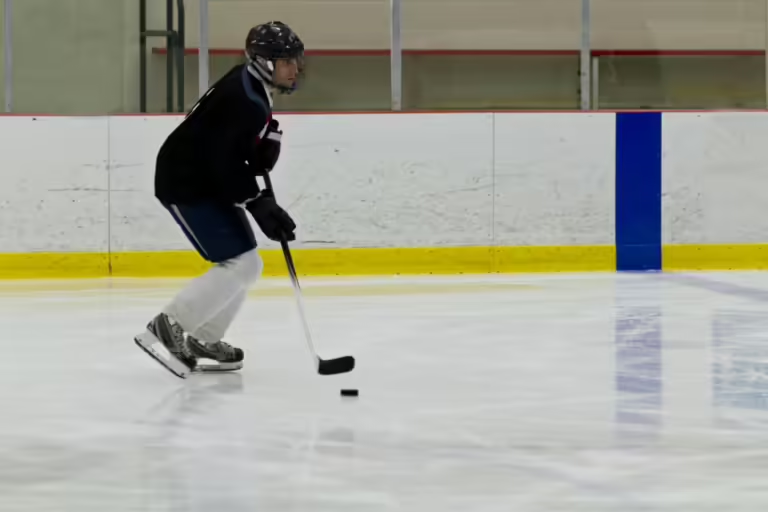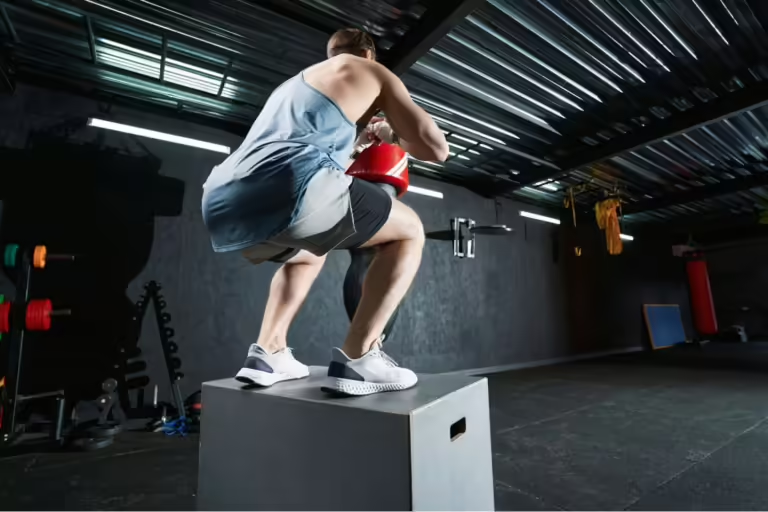Not skating like you once did? Watch any adult league hockey game and you’ll see what age does to the hockey player’s body – slower skating, more rigidity, less mobility and less agility.
But just because you’re getting older doesn’t mean your performance has to decline so rapidly. In fact, in many cases, older hockey players can improve their performance simply by reversing the inflexibility that comes with age.
Here are four absolutely essential stretches for older hockey players looking to improve their on-ice performance and ensure they can continue to play for decades to come.
Stretch 1: Elephant Walks [Back of Hips + Hamstrings]
When most people think about stretching their hamstrings, they think about bending and touching their toes. Unfortunately that’s just not an effective way to progress your hamstring flexibility.
Elephant walks are a dynamic version of the standard hamstring stretch. Of all the stretches on this list, elephant walks are likely the most uncomfortable but also the quickest to see fast results. You’ll be shocked at how quickly you’ll notice an improvement in your hamstring, lower back and hip flexibility by doing elephant walks a few times per day.
To perform the elephant walk, start standing with your feet slightly apart and bend down to touch the floor, but stop at your natural end range of motion. Take note of where your hands are. Find an object roughly at that height to support your hands on. While leaning on that surface, kick back your knees to straighten your legs alternating between left and right. Do 20 reps each leg 1-2 times per day.
Stretch 2: Couch Stretch [Front Of Hips + Quads]
You can do this stretch against a couch or a wall. The idea is to get in a lunge position but have your back leg propped up so your shin and hamstring are touching. You can also add some twisting motions in here to progress the stretch further.
This stretch is the perfect counter to elephant walks as they hit the front of the hips and the quadriceps to ensure you become more flexible in a balanced way.
Stretch 3: 90-90 [Outside Hips + Hip Flexors]
The 90-90 stretch is highly effective at stretching tight hip flexors. It’s such an effective stretch that simply getting into the starting position can itself be a good stretch for people with extremely tight hip flexors.
To perform this stretch, you’ll want to get on the ground and position your front leg with a 90-degree bend at the knee, and the back leg also with a 90-degree bend at the knee. Mindfully pull your chest forward to feel the stretch. It’s important to avoid rounding your back as that won’t stretch the hip flexors.
Stretch 4: Butterfly [Inside of Hips + Groin]
The final stretch is the butterfly. It’s a popular and simple stretch, but it’s necessary to perfectly balance out the prior three stretches. Hockey players are always at risk of groin injuries, so proper flexibility and maintenance is a smart insurance policy.
You can progress this stretch further by holding light dumbbells on the inside of your thighs to add downward pressure – but be careful not to go overboard or your body will fight back and refuse to stretch.
Why Focus On The Hips?
Hockey players have notoriously tight hip flexors. And if you spend the majority of your day sitting, you’re even more prone to tight hip flexors.
Tight hip flexors are a recipe for disaster as they are the connection between your upper and lower body. Imbalances within your hips can manifest as many different issues – lower back problems, hamstring problems, knee problems, shoulder problems and more.
By working on the flexibility of the four planes of hip mobility – inside, outside, front and back – you can ensure you have a proper base of hip health to optimize your hockey performance and to mitigate risk of injury as much as possible.
Stretching Improves Performance
Stretching, particularly the four stretches shown in this article, can significantly improve your lower body, lower back and hip flexibility. When your body moves well, you’ll be able to skate more efficiently, produce stronger skating patterns and increase your stride length.
Flexibility Reduces Injury Risk
One of the main reasons older hockey players stop playing is due to injury. By improving your flexibility in a few simple ways, you can decrease your risk of injury, allowing you to continue to play the game you love.
A study done in 2024 concluded that stretching can “significantly decrease muscle injuries”. Considering the most common injuries to hockey players are related to the lower body – hips, knees, ankles, hamstrings and lower back – improving the biomechanics of your lower body can help reduce those muscle injuries.
Another study concluded that hockey players are more prone to lower back pain than football players! The study goes on to state specifically that:
“Pain in the back and the musculoskeletal system as a whole cannot be completely prevented. The most common cause of pain is stretching of the muscles and protrusion of the intervertebral disc. Lower back muscle strain is often the cause of back pain. It often occurs in hockey players as a result of flexion and rotation while playing the sport, which leads to the abnormal stretching or tearing of muscle fibers, causing pain and limiting mobility. Excessive flexion and rotation can also cause protrusion of the intervertebral disc. The prevention of these conditions consists of extension exercises after consultation with a physiotherapist, observing correct ergonomics and regular stretching.”
Warning: Dynamic Stretching vs Static Stretching
There are two types of stretching – static stretching and dynamic stretching.
Static stretching consists of holding a stretch without moving for 30-45 seconds. Static stretching is typically performed immediately after exercise, or at least 2 hours before competition. In fact, static stretching should not be done within the 2-hours leading up to activity as it has been shown to decrease muscle performance. That’s right – static stretching immediately before a hockey game can actually hurt your performance!
Dynamic stretching consists of fluid, repetitive movements meant to warm-up your muscles and tendons. It is typically performed immediately before competition to prepare the body for activity.
Some of the stretches mentioned in this article are static stretches, which means they are meant to be held without moving for 30-45 seconds. This also means that they should not be done before your hockey practices and games. They should be reserved for post-workout, morning stretching or evening stretches – but not immediately before games, practices or workouts. The dynamic stretches mentioned would be fine to include in a pre-game warmup.
Stretch More To Stay On The Ice & Skate Your Best
Try to work these four stretches into your daily routine and watch your flexibility improve drastically, and for that flexibility to translate into better on-ice performance. Many people enjoy doing these stretches first thing in the morning, right before bed, or right after a workout. Do what works for you!





